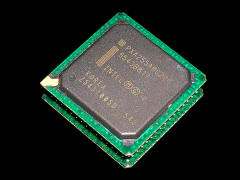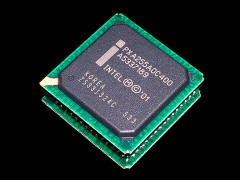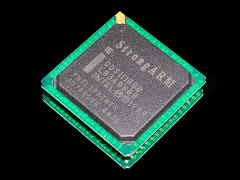PXA255
Introduction date:
Frequency:
Instruction Cache:
Data Cache:
Supply Voltage:
Power Dissipation:
Other Features:
|
March 2003
100 -
400 MHz
32 KB
32 KB
1 Volt
500 mW
- 2 KB "mini" Data Cache
- Extensive Data Buffering
- Enhanced 16-bit Multiply
- 40-bit Accumulator
- Flexible memory clock ratios
- Frequency change modes
- High Performance Memory Controller |
|
X-Scale: |
The PXA210 was
Intel's entry-level XScale targeted at mobile phone
applications. It was released with the PXA250 in
February 2002 and comes clocked at 133 MHz and 200 MHz.
The PXA25x family consists of the PXA250 and PXA255. The
PXA250 was Intel's first generation of XScale
processors. There was a choice of three clock speeds:
200 MHz, 300 MHz and 400 MHz. It came out in February
2002. In March 2003, the revision C0 of the PXA250 was
renamed to PXA255. The main differences were a doubled
internal bus speed (100 MHz to 200 MHz) for faster data
transfer, lower core voltage (only 1.3 V at 400 MHz) for
lower power consumption and write back functionality for
the data cache, the lack of which had severely impaired
performance on the PXA250.
source:
wikipedia |
|
Strong Arm: |
The SA-110 was the
first microprocessor in the Strong ARM family. It was
introduced in early 1996, debuting at 200 MHz. A 233 MHz
version followed in October 1996. Throughout 1996, the
SA-110 was the highest performing microprocessor for
portable devices. The SA-110 was available in 100, 160,
166, 200, and 233 MHz versions. The SA-110's first
design win was the Apple Message Pad 2000.[5] It was
also used in a number of products including the Acorn
Computers Risc PC and Eidos Optima video editing system.
The SA-1110 was a derivative of the SA-110 developed by
Intel. It was announced on 31 March 1999, positioned as
an alternative to the SA-1100. At announcement, samples
were set for June 1999 and volume later that year. The
SA-1110 was available in 133 or 206 MHz versions. It
differed from the SA-1100 by featuring support for 66
MHz (133 MHz version only) or 103 MHz (203 MHz version
only) SDRAM. Its companion chip, which provided
additional support for peripherals, was the SA-1111. The
SA-1110 was packaged in a 256-pin micro ball grid array.
It was used in mobile phones, personal data assistants
(PDAs) such as the Compaq (later HP) iPAQ and HP
Jornada, and the Simputer.
source:
wikipedia |
|







